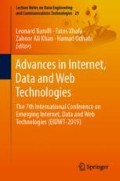Abstract
Underwater Wireless Sensor Networks (UWSNs) are promising and emerging framework having a wide range of applications. The underwater sensor deployment is beneficial; however, some factors limit the performance of the network, i.e., less reliability, high end-to-end delay and maximum energy dissipation. The provisioning of aforementioned factors have become challenging task for the research community. In UWSNs, battery consumption is inevitable and has a direct impact on the performance of the network. Most of the time energy dissipates due to the creation of void holes and imbalanced network deployment. In this work, a routing protocol is proposed to avoid the void holes problem and extra energy dissipation, due to which lifespan of the network increases. To show the efficacy of our proposed routing scheme, it is compared with state of the art protocols. Simulations result show that the proposed scheme outperforms the counterparts.
Access this chapter
Tax calculation will be finalised at checkout
Purchases are for personal use only
Notes
- 1.
Sink: This word is alternatively used for sink node, sonobuoy, destined node and destination node.
- 2.
Source: The words source node and initial node are alternatively used for source.
References
Khasawneh, A., Latiff, M.S.B.A., Kaiwartya, O., Chizari, H.: A reliable energy-efficient pressure-based routing protocol for the underwater wireless sensor network. Wireless Netw. 24(6), 2061–2075 (2018)
Hong, Z., Pan, X., Chen, P., Su, X., Wang, N., Lu, W.: A topology control with energy balance in underwater wireless sensor networks for IoT-based application. Sensors 18(7), 2306 (2018)
Wang, H., Wang, S., Zhang, E., Lu, L.: An energy balanced and lifetime extended routing protocol for underwater sensor networks. Sensors 18(5), 1596 (2018)
Khan, A., Ali, I., Rahman, A.U., Imran, M., Mahmood, H.: Co-EEORS: cooperative energy efficient optimal relay selection protocol for underwater wireless sensor networks. IEEE Access (2018)
Ahmed, F., Wadud, Z., Javaid, N., Alrajeh, N., Alabed, M.S., Qasim, U.: Mobile sinks assisted geographic and opportunistic routing based interference avoidance for underwater wireless sensor network. Sensors 18(4), 1062 (2018)
Sher, A., Khan, A., Javaid, N., Ahmed, S., Aalsalem, M., Khan, W.: Void hole avoidance for reliable data delivery in IoT enabled underwater wireless sensor networks. Sensors 18(10), 3271 (2018)
Nayyar, A., Puri, V., Le, D.-N.: Comprehensive analysis of routing protocols surrounding Underwater Sensor Networks (UWSNs). In: Balas, V., Sharma, N., Chakrabarti, A. (eds.) Data Management, Analytics and Innovation, pp. 435–450. Springer, Singapore (2019)
Wu, F.-Y., Yang, K., Duan, R.: Compressed sensing of underwater acoustic signals via structured approximation \( l_ 0 \) norm. IEEE Trans. Veh. Technol. 67(9), 8504–8513 (2018)
Khosravi, M.R., Basri, H., Rostami, H.: Efficient routing for dense UWSNs with high-speed mobile nodes using spherical divisions. J. Supercomputing 74(2), 696–716 (2018)
Gomathi, R.M., Manickam, J.M.L.: Energy efficient shortest path routing protocol for underwater acoustic wireless sensor network. Wireless Pers. Commun. 98(1), 843–856 (2018)
Hou, R., He, L., Hu, S., Luo, J.: Energy-balanced unequal layering clustering in underwater acoustic sensor networks. IEEE Access 6, 39685–39691 (2018)
Iwata, M., Tang, S., Obana, S.: Energy-efficient data collection method for sensor networks by integrating asymmetric communication and wake-up radio. Sensors 18(4), 1121 (2018)
Muhammed, D., Anisi, M.H., Zareei, M., Vargas-Rosales, C., Khan, A.: Game theory-based cooperation for underwater acoustic sensor networks: taxonomy, review, research challenges and directions. Sensors 18(2), 425 (2018)
Jan, M.A., Tan, Z., He, X., Ni, W.: Moving towards highly reliable and effective sensor networks (2018)
Yildiz, H.U., Gungor, V.C., Tavli, B.: Packet size optimization for lifetime maximization in underwater acoustic sensor networks. IEEE Trans. Industr. Inf. (2018)
Khalid, M., Cao, Y., Ahmad, N., Khalid, W., Dhawankar, P.: Radius-based multipath courier node routing protocol for acoustic communications. IET Wireless Sens. Syst. (2018)
Latif, K., Javaid, N., Ahmad, A., Khan, Z.A., Alrajeh, N., Khan, M.I.: On energy hole and coverage hole avoidance in underwater wireless sensor networks. IEEE Sens. J. 16(11), 4431–4442 (2016)
Wang, H., Wen, Y., Lu, Y., Zhao, D., Ji, C.: Secure localization algorithms in wireless sensor networks: a review. In: Bhatia, S., Tiwari, S., Mishra, K., Trivedi, M. (eds.) Advances in Computer Communication and Computational Sciences, pp. 543–553. Springer, Singapore (2019)
Yuan, Y., Liang, C., Kaneko, M., Chen, X., Hogrefe, D.: Topology control for energy-efficient localization in mobile underwater sensor networks using Stackelberg game. arXiv preprint arXiv:1805.12361 (2018)
Rahman, Z., Hashim, F., Rasid, M.F.A., Othman, M.: Totally Opportunistic Routing Algorithm (TORA) for underwater wireless sensor network. PloS ONE 13(6), e0197087 (2018)
Heidemann, J., Stojanovic, M., Zorzi, M.: Underwater sensor networks: applications, advances and challenges. Phil. Trans. R. Soc. A 370(1958), 158–175 (2018)
Javaid, N., Majid, A., Sher, A., Khan, W., Aalsalem, M.: Avoiding void holes and collisions with reliable and interference-aware routing in underwater WSNs. Sensors 18(9), 3038 (2018)
Coutinho, R.W.L., Boukerche, A., Vieira, L.F.M., Loureiro, A.A.F.: Geographic and opportunistic routing for underwater sensor networks. IEEE Trans. Comput. 65(2), 548–561 (2016)
Xu, J., Li, K., Min, G., Lin, K., Qu, W.: Energy-efficient tree-based multipath power control for underwater sensor networks. IEEE Trans. Parallel Distrib. Syst. 23(11), 2107–2116 (2012)
Author information
Authors and Affiliations
Corresponding author
Editor information
Editors and Affiliations
Rights and permissions
Copyright information
© 2019 Springer Nature Switzerland AG
About this paper
Cite this paper
Mateen, A., Javaid, N., Bilal, M., Farooq, M.A., Khan, Z.A., Riaz, F. (2019). Towards Optimizing Energy Efficiency and Alleviating Void Holes in UWSN. In: Barolli, L., Xhafa, F., Khan, Z., Odhabi, H. (eds) Advances in Internet, Data and Web Technologies. EIDWT 2019. Lecture Notes on Data Engineering and Communications Technologies, vol 29. Springer, Cham. https://doi.org/10.1007/978-3-030-12839-5_48
Download citation
DOI: https://doi.org/10.1007/978-3-030-12839-5_48
Published:
Publisher Name: Springer, Cham
Print ISBN: 978-3-030-12838-8
Online ISBN: 978-3-030-12839-5
eBook Packages: Intelligent Technologies and RoboticsIntelligent Technologies and Robotics (R0)

